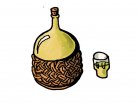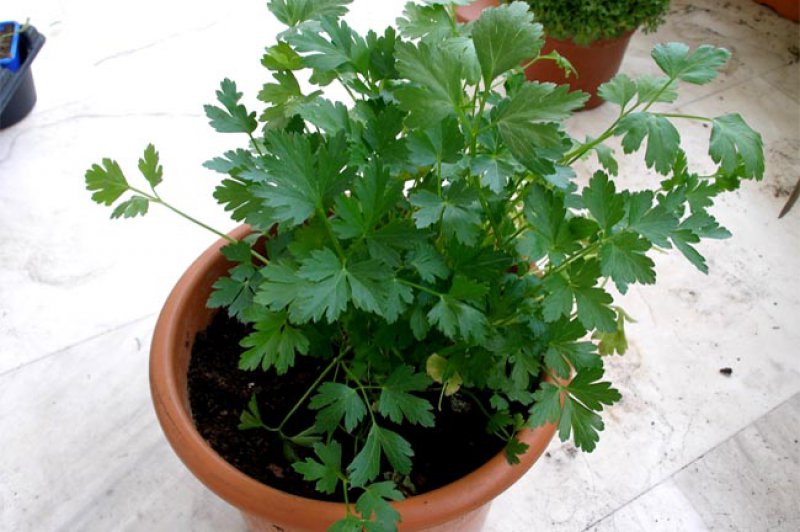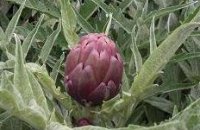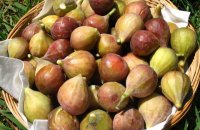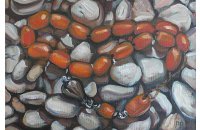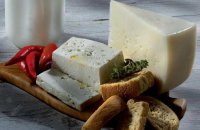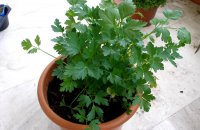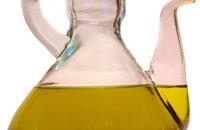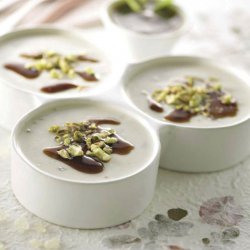For one reason or another, this ubiquitous herb inspires metaphor. One friend and fellow cook recently compared it to air in that it is everywhere around you, yet so easily taken for granted. In Greek, there is even a metaphor for people, especially public figures, who seem to be everywhere at once; Greeks will disparagingly call them "parsley".
Unlike air, of course, (but like most mothers-in-law) parsley is highly visible. Its greatest virtue, in fact, seems to be its ability to brighten up even the dullest dish. Color aside, parsley's other chief merit is its ability to meld into a dish and never overwhelm, to add instead a pleasant coolness. But parsley is in fact much more than a flash of green used to garnish one side of the plate. Like most herbs, it has a history both ancient and proud, and, surprisingly, once you stop to really taste it, it has a flavor that is vibrant and fresh.
While there are several kinds of parsley, two are common commercially -curly parsley, valued more as a garnish, and flat-leaf parsley. Both are cultivated varieties of Petroselinum crispum. The herb's scientific name derives from the Greek "Petroselino," a synonym for what we now call "maidano." This name originates in parsley’s close resemblance to celery leaves, and in the fact that its favorite home in the wild is, indeed, among the rocks.
Yet, for all its ubiquity, the Greeks were never particularly taken by parsley's virtues. The ancients fed it to horses and sometimes to warriors; they used its leaves for decoration and to weave into the wreaths placed on victorious athlete's heads. They scattered parsley over tombs in the ancient world, as homage to the snake-slain Archemorus, the herald of death. They also believed it to possess a few medicinal uses as well, namely as an antidote to drunkenness.
Parsley is the richest plant source of vitamin A, and also loaded with chlorophyll and vitamin C. It has remained a kitchen staple since Roman times, where it was used frequently as an aromatic in sauces. (Among the Greeks, it was used chiefly as a medicine and not a food, and there is no mention of it in the Deipnosophists.) In France, cooks have always made good use of parlsey. The 14th century chef Taiilevent gave a recipe for green sauce made with parsley, ginger, vinegar, and soaked bread. Today, it is a staple in the bouquet garnit which flavors stocks; mixed with lemon juice it becomes maitre d'hotel butter; with chives, chervil and tarragon it makes for fines herbes; and chopped together with garlic, it makes the seasoning persillade, which is added to stews at the end of cooking. Parsley is a key component in the classic tartar sauce. French chefs also deep-fry sprigs of parsley, according to a deep-rooted tradition.
The herb figures heavily in Italian cooking, too, as well as in the cuisines of Greece and the Middle East. In Italy, it is almost always cooked with other ingredients rather than used raw. In Greece, it is a standard in meatballs. Macedonians lay claim the most extensive use of parsley, most prominently in their unusual parsley fritter recipe. It is also a standard in marinades for grilled fish, as well as one of the basic aromatics in soups and stews. In Crete, it is used as a wild green, and added to meat and fish stews that are then dressed with avgolemono. Chicken with parsley and egg-lemon sauce is an unusual but well-known Cretan dish. In Syros, along with other places in the Cyclades, the herb is often used to make a kind of pesto, mashed that is, with bread, garlic and olive oil and served as a dipping sauce. In the Middle East, it is eaten as a green, and raw, it is one of the main ingredients in tabbouleh, a salad of bulgur wheat and tomatoes.
Unlike other herbs, parsley does not dry well. Its flavor becomes dank and musty, and it loses all of the perkiness that characterizes it when it is fresh.
The Ubiquity of Parsley
I've always considered parsley the culinary equivalent of a good mother-in-law: always there but never too intrusive.
Country:
Category:












































